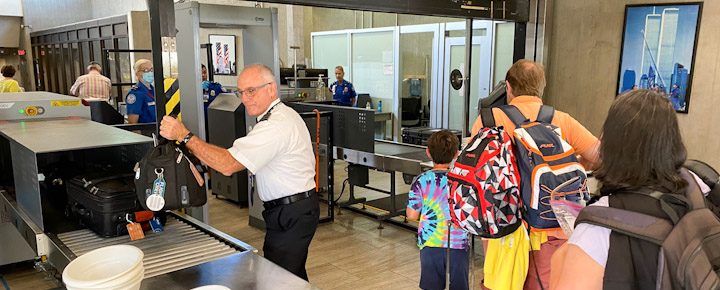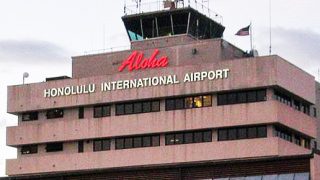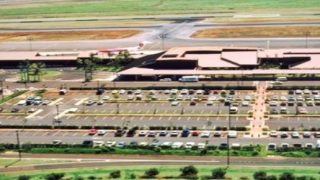Starting now, visitors to Hawaii will experience state-of-the-art Transportation Security Administration (TSA) digital biometric screening that is controversial to some travelers. The goal is a better and faster screening experience for Hawaii visitors, especially during a busy summer travel season.
On a recent trip to London, we found this and other new biometric technology was mandatory and used upon arrival in Heathrow. There were no immigration officers. A self-service scanner examined passports and took photos. We walked out in seconds.
On arrival back in the USA, editors encountered the option of standing in a long arrival line for customs and immigration in Seattle (over an hour’s wait) or downloading the Mobile Passport Control App, which took photos and scanned passports. There was no wait at all for those who chose that.
So if it saves us time and allows officers to focus on those few travelers who could be a possible threat, what’s the problem? One word perhaps, and that’s privacy.
Some US legislators are skeptical and face off with TSA.
Senator Ed Markey of Massachusetts said, “You don’t have to compromise people’s biometric security in order to provide physical security at airports.” Five U.S. senators previously sent a letter demanding that TSA stop the biometric program.
TSA agreed in concept that they want to protect passenger privacy, with their Administrator saying, “I want to deploy technology that’s accurate and doesn’t disadvantage anybody.”
Others are concerned about the lack of regulations focused explicitly on biometric privacy. Also, the technology may be less accurate for people of color.
Honolulu Airport is now using 4 advanced systems.
Credential Authentication Technology (CAT-2) is at its security checkpoints. These digitally examine visitors’ faces and rapidly compare them with their photo IDs. It’s also compatible with new driver’s licenses some states are issuing that can be uploaded to mobile devices.
Boarding passes are no longer generally required when going through the new checkpoints. However, we have noticed that the officers sometimes still ask for them, which can catch visitors by surprise.
What happens is that your photo ID is scanned and checked against the Secure Flight Database, which contains the passenger flight details and TSA PreCheck if applicable.
The equipment in Hawaii is the same as is being used for testing at more than two dozen US airports.
Participation in TSA biometrics at Hawaii Airports.
It’s optional. That’s the policy for now. But what happens in the future is unclear. We noticed that passengers who disagree with this technology would be placed on a no-fly list at Gatwick Airport in England, for example.
While TSA says that images are used on the spot and “mostly” never stored, it confirms that some encrypted data may be retained for up to 2 years as part of an ongoing technology review.
Hawaii now has advanced carry-on screening.
In addition to the new passenger screening coming to Hawaii, the agency has installed Computed Tomography X-ray (CT) scanners, similar to that used in medicine, for carry-on screening imaging. It’s also known as cross-sectional imaging.
Those are found at all of Hawaii’s airports, although Lihue Kauai has the most units. There are four at Lihue, while Hilo, Honolulu, and Kona have one each. There are two at Maui.
The 3D images obtained from carry-ons vastly reduce any physical rescreening of those bags and greatly speeds their screening process. When being screened using CT technology, there is no need to remove either laptops or approved-quantity liquids from carry-ons.
One difference between these is that they feature much larger bins. Everything, including the bags, must be placed into the bins when screened.
While it takes somewhat longer for TSA officers to utilize 3d imaging, the fact that it so significantly reduces the need for manual manipulation of contents is safer for officers, and our carry-ons, and ultimately, without bags going out of x-ray and then back in, is a big time-saver and stress reducer for everyone.
BOH: It’s somewhat confusing to know what procedures to follow, which vary depending on the technologies used. We went through screening at Lihue this weekend with the new 3d CT scanner and found it was indeed a much faster process.
TSA on new facial recognition.
TSA said, “We view this as better for security, much more efficient, because the image capture is fast and you’ll save several seconds, if not a minute. Facial recognition, first and foremost, is much, much more accurate. And we’ve tested this extensively. So we know that it brings the accuracy level close to 100% from mid-80% with just a human looking at a facial match.”
TSA dogs are also being used in Hawaii screening.
Hawaii TSA is also continuing to use specially trained dogs, both at Honolulu Airport and, more recently, on Maui. They were added to the valley isle last fall. The canines do a real-time assessment of threats at security checkpoints and are trained to detect explosives.
We mentioned other new Hawaii TSA changes recently.
If you are traveling to Hawaii over the next few months, stay current with our recent post on what to expect at Hawaii airports this summer.
Get Breaking Hawaii Travel News






I agree with Tim. If you have been in Europe, cameras are everywhere. British crime shows always have the detectives asking for the CCTV footage. I have always assumed that I am on camera the minute I get near an airport. Get used to it.
Contentious? Why are trying to stir up something with the paranoid fringe? I first encountered that system at Dulles in DC area several years ago. It’s awesome. Just need ID instead of boarding pass and ID. Should be in every major airport.
You seem to imply that because a number of other airports are using this technology that it brings some validation to it. Personal privacy is systematically being removed in this country and one can strongly argue that it is a violation of our basic 4th Amendment rights as government has no Legal right to do so other than purporting to protect everyone.
Where do you draw the lines now? Are there any lines left?
We are approaching pre-WWII Germany and certainly post-WWII eastern Europe where I used to work and travel.
Statism is “the principle or policy of concentrating extensive economic, political, and related controls in the state at the cost of individual liberty.” Not what the Founders had in mind. Wake up.
Hours long wait vs no line, I choose no line every time. And really, if you are in an hours long line an airport do you really think you are not on dozens of cameras anyway ?
The facial recognition technology worries me in that millions of us have doppelgangers – and what is to prevent a terrorist from getting plastic surgery (or using make-up artistry), changing their hair color, etc. in order to avoid detection? I’d rather see technology focused on scanning carry-on luggage. And, let’s spend money hiring more personnel to monitor passengers as they pass through. Mahalo and Aloha.
What’s stopping someone from stealing your ID and doing the same?
Aloha Nel – Exactly, and that’s why we need to focus more on examining carry-ons and physical searches. Hopefully, we won’t have to resort to the intense screening that Israel has in place, but its citizens gladly accept the inconvenience because of the safety it provides.
Focus more on examining carryons and physical searches. Do you mean that in a way where it is more intensified and extensive than already is? In my opinion that would slow the process of going through TSA security down even slower, especially during rush times and in big airports.
2 years,24 months, it all breaks down the same for most of us. When dealing with any government, especially ours, 2 years is rarely ever 2 years. Biometrics was the latest and greatest 15 years ago, if not more, and they haven’t developed anything better since. Buckle up, this will prove to be a bumpy ride.